Posts Tagged ‘striking error’
Is your H.G. Wells £2 coin worth thousands? How to spot if you’ve got an ‘error’ coin!
Every keen collector knows that it is worthwhile paying close attention to the small details of your coins – it’s the only way you can ever hope to spot an error.
From edge inscription mix ups to inverted effigies, there are a few stories that crop up more often than not. However, recently, a couple of ‘error’ stories have cropped up, that Change Checker really think you should pay attention to – involving an H.G. Wells £2 and the Technology £2…
Stay tuned as we take a closer look at these ‘errors’ and help you determine if your £2 coin is a genuine rarity!
H.G. Wells £2 – Blank ‘Error’
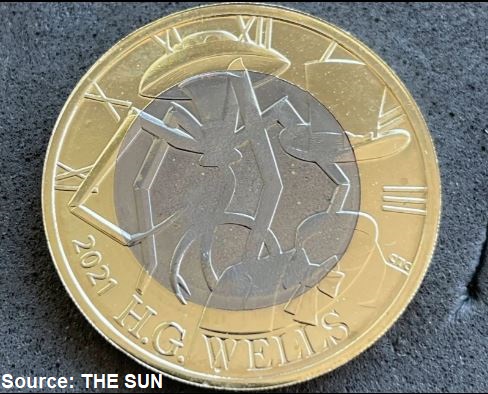
This £2 coin was issued as part of the 2021 UK Commemorative Coin set and it marks the 75th anniversary of the death of science fiction novelist, H. G. Wells.
With the clue in the name, this bi-metallic coin is made up of a combination of a silver coloured cupro-nickel disc and an outer yellow nickel-brass ring.
In the case of this H.G. Wells £2 coin however, it appears that the blank used has a thicker yellow ring, much wider than what we’d see on normal £2 coins.
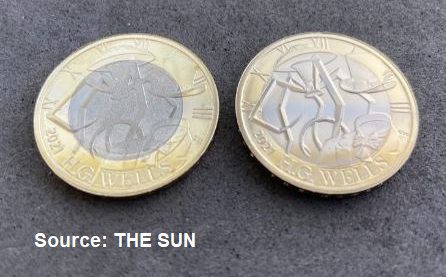
When striking £2 coins, the first step is to punch a hole through a blank planchet to create the outer section. The inner core is taken from a different metal, sized to fit inside the outer ring.
There have already been estimations that if this coin was to be sold at auction, it could fetch over £1,000! We’re going to be eagerly awaiting confirmation from The Royal Mint whether this error is genuine or not. Nonetheless, it certainly makes for interesting collecting!
This coin is yet to be individually issued, so any ‘error’ versions will have come exclusively from the 2021 UK Annual Set. It’ll certainly be interesting to see if any other stories crop up after the coin’s individual issue….
Whilst there are no identical examples to compare the H.G. Wells £2 ‘error’ to, there have been previous instances of the inner and outer sections of £2 coins not quite matching up:
Clipped Planchet
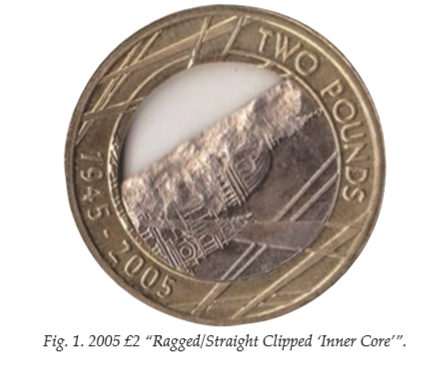
In the above image, the inner core was punched out from the end of the sheet of metal used for blanks, forming a straight or ragged edge clip.
Whilst this also occurs with monometallic coins, the pairing with an outer ring exposes a large gap which is much more noticeable.
The Royal Mint strike millions of coins each year so it is inevitable that variances will occur during the striking process and can’t always be picked up during quality control, despite the fact that this particular coin would weigh less than the standard 12g £2 coin.
Off Centre Inner Core
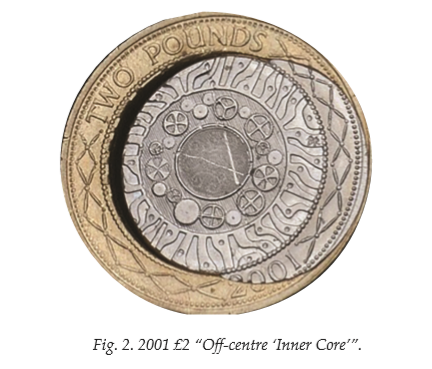
The inner core of this coin hasn’t been united properly prior to being struck, resulting in an off centre inner core.
Due to the way the inner and outer core are struck together with the two metals being lined up and then fused together during striking, a misalignment will mean that the inner core spills into the outer ring, as seen in the image above. There might also be a gap between the two metals on the opposing join.
Faulty Outer Ring
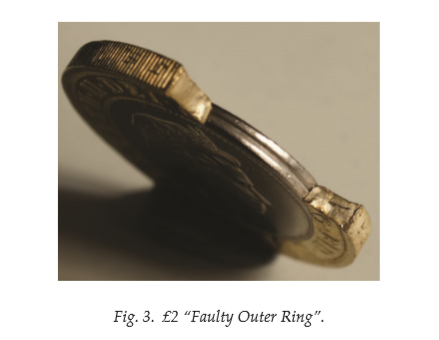
This particular mis-strike, shows a faulty planchet or outer ring, where the inner core is exposed.
In the image above, you can actually see the specific engineering design features where the inner core is grooved to help the metal flow bond to the outer ring and fuse during striking.
Similar to the first mis-strike we looked at, this could be caused by a clipped planchet, this time created when the outer ring was punched, however coins like this may also be caused by tampering post striking, for example by fakers trying to replace the inner core of a £2 with another coin to pass off as a rare error.
Bronze £2 Error
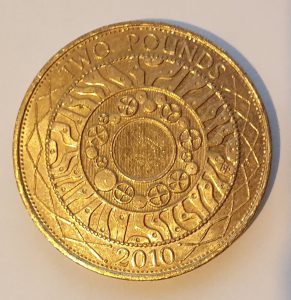
The ‘Monometallic’ £2 is described as the Holy Grail of bimetallic ‘errors’ and is the result of the nickel-brass £2 blank not having the inner core section punched out before being struck.
This means that the £2 coin is made from one full piece of nickel-brass, completely contrasting the very idea of a bimetallic coin.
A 2007 monometallic £2 was verified by The Royal Mint and in the email confirming the mis-strike it was mentioned that they had only seen 4-5 similar coins before.
However, in 2021, Change Checker was contacted by a collector called Amin who informed us that he had found this exact error coin but with a 2010 date.
After sending details of his coin to The Royal Mint for further information, it was confirmed to be genuine error as a result of the minting process.

This rare striking error is highly sought-after and coins have achieved extraordinary prices in private sales and auctions.
Whilst information of this coin’s sale has remained private, it’s certainly a very interesting story and we imagine the collector can expect to see a very impressive return on this coin…
We look forward to the individual release of the HG Wells £2 later this year and will certainly be keeping our eyes peeled for any unusual looking variations!
Have you ever come across any of these £2 error coins in your collection?
We’d love to know! Comment below.
Secure the 2021 UK Commemorative Coin Set – featuring the H. G. Wells £2!
Face-less Value! Do you have this £10 note error worth thousands of pounds?
The UK’s new polymer £10 note, featuring Jane Austen, entered circulation on 14th September 2017, replacing the previously-used paper notes.
After its release, collectors were eager to hunt down the notes with the lowest serial numbers but it’s recently been revealed that there is a particular error that we should be looking out for – one that’s worth thousands!

Faceless £10 Note
One lucky collector was very surprised to see Her Majesty’s portrait missing some very key features on the £10 note that he withdrew from a cash machine.

The gentleman was almost about to spend the note before a shop assistant pointed it out to him! Speaking of the unusual banknote, Mr. Coleman said he was considering auctioning it.
Whilst we’d love for this to be a genuine error, we’ll have to wait for official confirmation from the Bank of England!
Sought-after Banknotes
Collecting banknotes is a serious hobby that many thousands of people all over the world enjoy. Whenever a new banknote is issued, or an error story arises, collectors are eager to add them to their collection.
With so many stories in the press and listings on eBay claiming certain notes were worth way over face value, it’s easy to see how the nation got swept away with the idea of their new polymer banknote being worth thousands of pounds.
Whilst there’s a range of serial numbers that could fetch you a pretty penny on the secondary market, we’ve never seen an error quite like the Faceless £10 Note. If this is classified as genuine, it would certainly increase collector demand!
Do you have this error note sitting in your collection?
If you think you’ve got a banknote with Her Majesty’s portrait missing its features, we’d love to hear from you! You can get in touch via [email protected] or via any of our social channels:
Don’t miss out on the very latest UK coin releases!
Join the Change Checker UK CERTIFIED BU Subscription Service and receive new UK coins sent to your door without the hassle of placing orders on the day of release!
Simply choose the perfect subscription for you here >>
Have I found a rare coin? £2 ‘errors’ explained!
So you’ve noticed something’s not quite right with the £2 coin you’ve just found in your change. A quick google search of the strange variation you’ve noticed brings up a plethora of eBay listings and news articles claiming that you’ve just hit the jackpot and your ‘error’ coin is worth a small fortune!
Sadly, in this instance Google is not your friend and whilst genuine errors are out there, so too are a number of common mis-strikes and myths, or even fakes that have been manipulated to look like an error.
So what is the difference between a mis-strike and an error I hear you ask.
Put simply, a true error is caused by human mistake, such as the wrong die or metal being used to strike a coin, whereas a mis-strike is created by the mass production process, as hundreds of thousands of coins are struck, meaning variations are bound to occur, especially when dies and machinery become worn.
But which mis-strikes on the bi-metallic £2 coin should you be aware of?
I recently read Scott Wren’s article, ‘Bi-metallic “errors”… Why two is better than one’ published in Coin News which highlights some of the mis-strikes found on £2 coins and how their bi-metallic quality causes the differences to be something entirely more spectacular than those found on monometallic (single metal) coins.
Striking bi-metallic coins
In order to understand why mis-strikes on bi-metallic coins are often more pronounced than monometallic coins, it’s first a good idea to look into how these coins are produced.
When striking £2 coins, the first step is to punch a hole through a blank planchet to create the outer section. The inner core is taken from a different metal, sized to fit inside the outer ring.
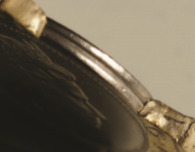
A groove is milled around the edge of the inner core so that when both parts are struck together, the metals will fuse as the outer ring deforms and spread into the groove, locking it into place.
Now that we know how £2 coins are struck, here are some of the mis-strikes and errors that can occur in the process…
The following images of variations found on £2 coins have been taken from Coin News for use in this blog.
Clipped Planchet

Figure 1 shows how the inner core was punched out from the end of the sheet of metal used for blanks, forming a straight or ragged edge clip.
Whilst this also occurs with monometallic coins, the pairing with an outer ring exposes a large gap which is much more noticeable.
The Royal Mint strike millions of coins each year so it is inevitable that variances will occur during the striking process and can’t always be picked up during quality control, despite the fact that this particular coin would weigh less than the standard 12g £2 coin. However, a small quantity of coins do sometimes manage to slip through the net and as i’m sure you’ll agree, they make for interesting collecting.
But before you pay over the odds for one of these coins, beware of fakers! Some coins are manipulated to look like mis-strikes or error coins and sold to unsuspecting buyers. Check the clipped planchet edge of the coin to see if it’s genuine by making sure the detail of the design fades away towards the edge rather than suddenly stopping, which would indicate the coin had been cut.
Off Centre Inner Core

Figure 2 shows an inner core which hasn’t been united properly prior to being struck.
Due to the way the inner and outer core are struck together with the two metals being lined up and then fused together during striking, a misalignment will mean that the inner core spills into the outer ring, as seen in the image above. There might also be a gap between the two metals on the opposing join.
This mis-strike is thought to be fairly common on the bi-metallic 12 sided £1 coin as well as some of the Technology £2 coins and even foreign bimetallic coins, but have you ever spotted one in your change?
Faulty Outer Ring

Figure 3 shows a faulty planchet or outer ring, where the inner core is exposed.
In the image above, you can actually see the specific engineering design features where the inner core is grooved to help the metal flow bond to the outer ring and fuse during striking.
Similar to the first mis-strike we looked at, this could be caused by a clipped planchet, this time created when the outer ring was punched, however coins like this may also be caused by tampering post striking, for example by fakers trying to replace the inner core of a £2 with another coin to pass off as a rare error.
The Holy Grail of Bi-metallic ‘Errors’
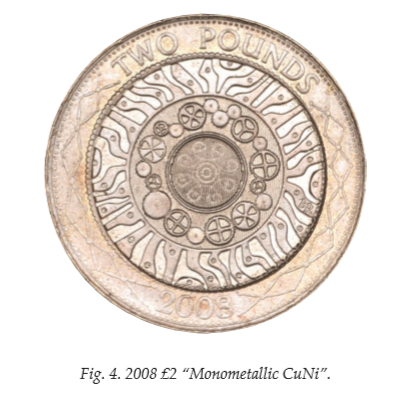
Figure 4 is described as the Holy Grail of bimetallic ‘errors’ and is the result of the nickel-brass £2 blank not having the inner core section punched out before being struck.
This means that the £2 coin is made from one full piece of nickel-brass, completely contrasting the very idea of a bimetallic coin.
A 2007 monometallic £2 was verified by The Royal Mint and in the email confirming the mis-strike it was mentioned that they had only seen 4-5 similar coins before.
This rare striking error is highly sought after and coins have achieved extraordinary prices in private sales and auctions.
Foreign Planchet
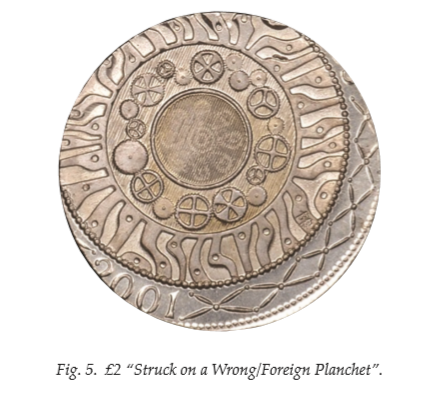
Finally, figure 5 shows a £2 design struck on the wrong planchet – a blank normally used to strike a different coin.
As The Royal Mint strikes a huge quantity of coins for different denominations and even different countries, blanks can sometimes end up in the wrong striking chamber, creating a wrong or foreign planchet error.
This is actually down to human error rather than a mis-strike and the coins would normally be picked out during quality control, however some have been spotted in circulation, not only on the £2 coin, but on various different denominations across UK coins and world wide.
One of the most famous examples in the UK is the silver 2p – a 2p coin struck on to a 10p blank which sold for 67,580 times its face value at auction.
Other £2 ‘errors’ that are worth keeping your eyes peeled for!
2014 First World War (Lord Kitchener) £2 – Two Pounds ‘Error’
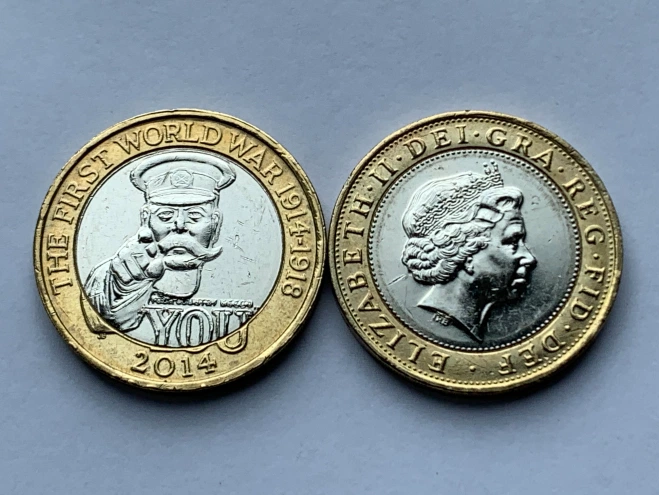
This £2 coin was issued in 2014 to mark 100 years since the outbreak of the First World War. It features an image of Lord Kitchener who was a prominent figure on British government propaganda campaigns during the time.
5,720,000 of these coins entered circulation, meaning it could be quite easy to stumble across one in your change. However, a small number of these coins are supposed to have entered circulation without the ‘Two Pounds’ denomination on the obverse.
Sometimes the denomination of the coin will feature on the reverse design, meaning it won’t appear on the obverse too. This can be seen on the Trinity House £2 coin which was issued earlier in the same year as the First World War £2.
It’s possible that the dies used to strike the obverse of the Trinity House £2 coin wasn’t replaced when the production of the First World War Centenary £2 coins began, resulting in the absence of a denomination.
We’ve only heard of two reports of these ‘error’ coins being found in circulation. However, Lockdales Auctioneers officiated the sale of the very first one back in March 2020 to the value of £500! A hefty return on a £2 coin…
Have you ever seen this £2 ‘error’? We’d love to know in the comments below.
So how much is my ‘error’ coin worth?
These mis-strikes and errors certainly make for interesting collecting and the rarer variations, such as monometallic £2 coins could certainly sell for over face value.
In fact, one such monometallic mis-strike found on a 2007 Technology £2 is estimated to be worth over £1,000!
Ultimately, as with all coins, it’s all down to how much an individual collector is willing to pay to add that coin to their collection.
If you’ve found a £2 coin with a mis-strike, it’s certainly worth having it verified and authenticated by The Royal Mint, who will supply a letter detailing their findings.
So have you found any interesting variations on your bimetallic £2 coins? Let us know in the comments below!
With thanks to Scott Wren from Coin News.
If you’re interested in coin collecting, our Change Checker web app is completely free to use and allows users to:
– Find and identify the coins in their pocket
– Collect and track the coins they have
– Swap their spare coins with other Change Checkers
Sign up today at: www.changechecker.org/app



